How to Repair External Hard Disk Not Detected Updated
How to Repair External Hard Disk Not Detected
Removable deejay drives—like USB flash drives, SD cards, and external hard drives—should be easy to use with your calculator. Just in some cases, you may connect your drive to a Windows PC or another device with a USB port and find the external hard drive isn't showing up.
This problem has several possible causes: sectionalization issues on the external drive, using the wrong file arrangement, dead USB ports, or driver bug in Windows. In a worst-case scenario, the bulldoze itself may be dead.
Let'due south take a look at what to do when your external hard drive is not showing up in Windows. Note that this guide is also available as a video:
1. Brand Certain Your External Bulldoze Turns On
This is a preliminary pace, merely notwithstanding one worth checking. Nearly every flash drive, and many external hard drives, don't require a separate ability source—they receive power over USB. However, some desktop external drives do have dedicated power cables, or at least a physical power switch.
If this is the case and your external hard drive is non showing up, you could have an issue with the device'due south power cablevision. Endeavour plugging it into another power outlet, or swap the cable if possible. Cheque for signs of activity, like flashing lights on the unit or move inside the bulldoze, before moving on.
If yous don't see any signs that the drive is working no matter what you lot exercise, the device might be dead. Be sure to know the signs that your hard drive is failing and then you tin can catch it early if this happens again.
Assuming that your drive turns on only still doesn't show up, walk through the below points in social club.
2. Check the Drive in Disk Direction
You should first check whether Windows detects the hard disk when yous plug it in. Plug your removable drive into your calculator, if it isn't already.
Next, open the Disk Management tool. To do and so, printing Win + X (or right-click the Start button) to open the Power User card and select Disk Direction from the list. You tin also open the Run dialog with Win + R and enter diskmgmt.msc to open this utility.
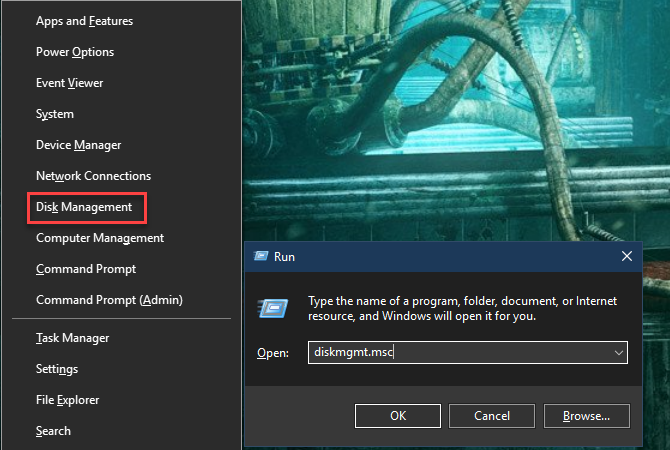
As the name suggests, Disk Management lets yous see all the hard disks continued to your estimator. It allows you to review sizes, partitions, and other deejay data.
You should see your external drive listed in the Disk Management window, likely beneath your main and any secondary disks. Even if it doesn't appear in the This PC window because it doesn't incorporate any partitions, it should show up here equally a Removable volume.
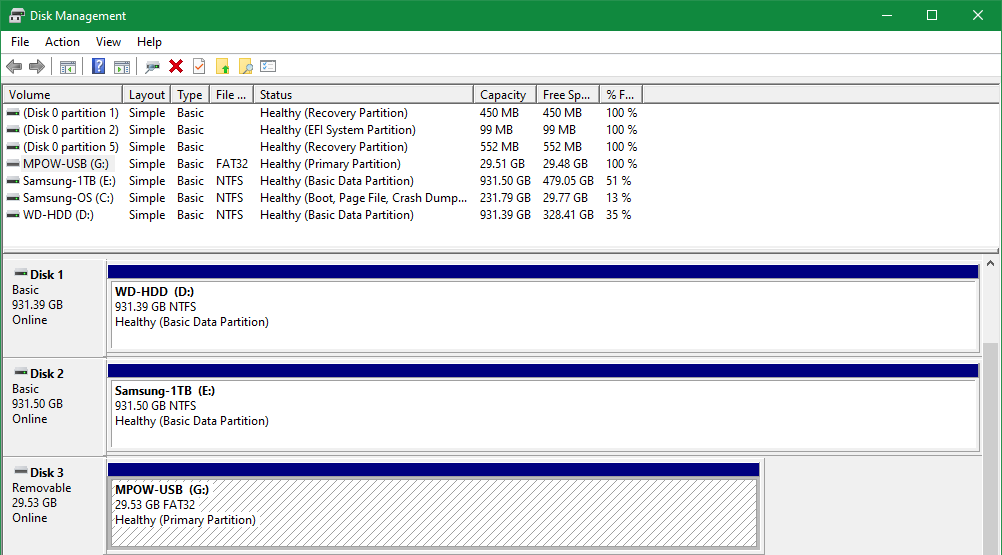
If you exercise see the drive here, jump down to section #5 below. There, you'll partitioning and/or format your drive properly so Windows and other devices tin can access it.
If your external drive is still not showing up in Deejay Management, continue on. Y'all'll need to determine why your bulldoze isn't recognized. It's possible you accept a hardware outcome, driver problem, or a expressionless drive.
3. Try Some other USB Port and Calculator
The reason your external drive isn't detected may not lie with your device, but instead with the port yous're using to connect it to your computer.
Unplug the drive from its current USB port and try plugging it into another port on your computer. Should it piece of work in i USB port just not some other, you may have a expressionless USB port. Encounter how to diagnose and set dead USB ports if you suspect this.
If you lot've plugged the drive into a USB hub, try connecting information technology directly to the figurer instead. Some USB hubs don't provide enough ability for your external bulldoze to function.
What if the drive doesn't show up in Disk Management even after trying both of these steps? It's tough to know for certain whether the drive is bad or your figurer is having a problem. If you take some other computer nearby, try plugging the external deejay into that to check whether information technology's detected.
If the drive doesn't work on any reckoner yous plug it into, the bulldoze itself is likely dead and you'll demand to replace information technology. When y'all try another machine, exist sure to bank check whether it appears in the calculator'due south Disk Management window, equally discussed to a higher place.
Even if it'south working, the drive might not appear in the This PC panel of File Explorer if it lacks a volume that Windows can identify.
4. Troubleshoot Device Commuter Bug
If the drive does testify up on other computers—or you don't take another reckoner around to test it on—Windows may take a commuter problem with your device. Y'all can check for this using the Device Manager.
You'll find a shortcut to the Device Manager under the same Win + X menu mentioned earlier. Y'all can also enter devmgmt.msc into the Run dialog to open up information technology.
In the Device Manager, expand the Disk drives category and bank check for any devices with a yellow exclamation point side by side to them. It's a practiced idea to check the Universal Serial Bus controllers department besides.
If yous run across the fault symbol for any entry, that device has a driver problem. Right-click the device with the issue, select Properties, and wait at the error message under Device status. This info tin can help yous fix the trouble.
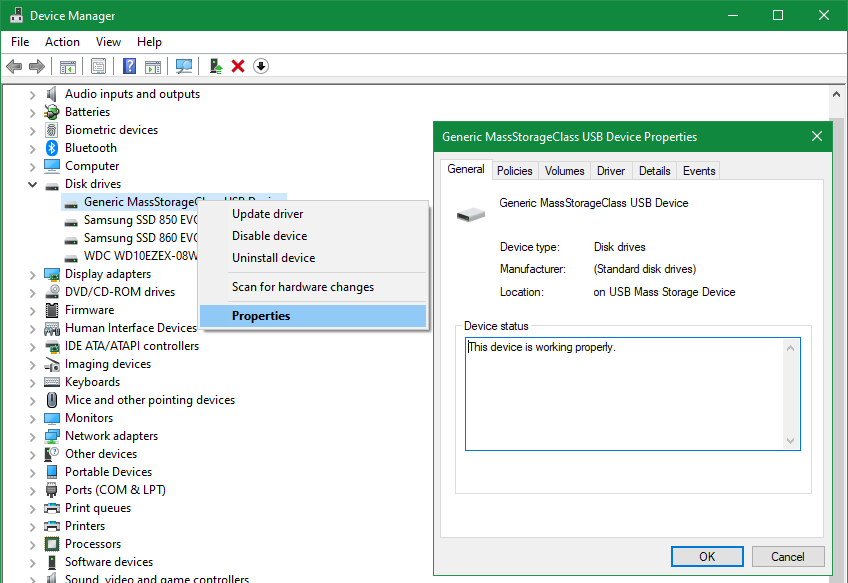
We've explored how to fix the "This Device Cannot Start (Code x)" fault every bit well equally fixes for "Unknown USB Device", which provide good troubleshooting steps for driver issues. There are some more general steps you lot can take if those guides don't work for your result, though.
Driver problems tin be tricky to fix. If the problem started recently, attempt running System Restore to roll dorsum the changes. If that doesn't help, you can right-click on the affected device in the Device Managing director and use the Update Driver push button to install an updated driver.
However, this rarely finds a new driver for generic devices similar flash drives. Instead, you may want to bank check the manufacturer'southward website for a specific driver for your external hard drive; see our guide to updating Windows drivers for more help.
The Driver tab that appears in the Properties carte du jour for each device in the Device Manager has a few other options. Scroll Back Driver will revert whatsoever contempo driver updates (if applicable), which probably won't have an event if Organisation Restore didn't work.
As a last resort, you can utilise the Uninstall Device button to remove the device from your system. Upon rebooting, Windows will then reinstall the driver and hopefully configure it correctly when yous reconnect the drive.
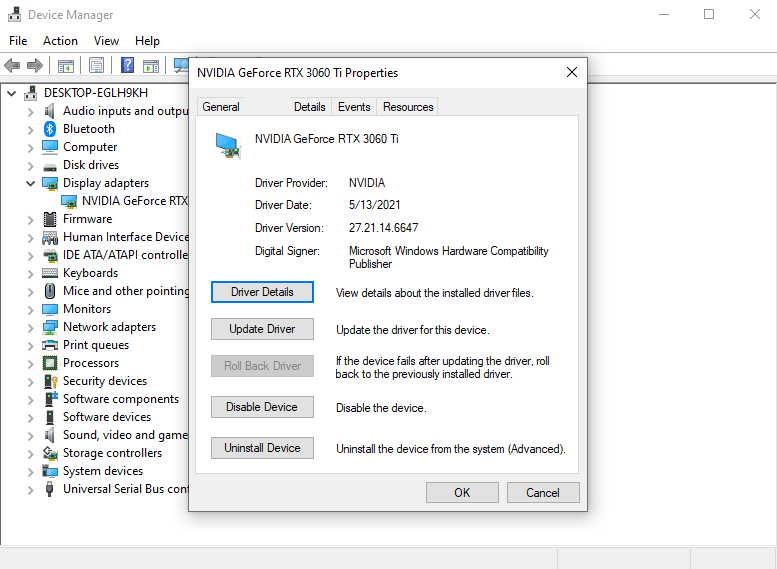
5. Create a New Drive Book
If your device showed upward in Deejay Management in #2 before, or ane of the above troubleshooting steps made Windows discover it, yous're prepare to initialize the drive and so it'south usable. Aside from showing you basic data, the Deejay Management tool tin can also fix partition and file system issues with your drive.
If your removable drive shows only Unallocated space, y'all'll need to create a new sectionalization on it. This allows Windows and other operating systems to use the device. To make a new segmentation, right-click anywhere on the Unallocated space, select New Simple Book, and go through the sorcerer to create a new partition.
Once the drive has a partition on it, y'all should be able to see it in This PC and employ information technology as normal.
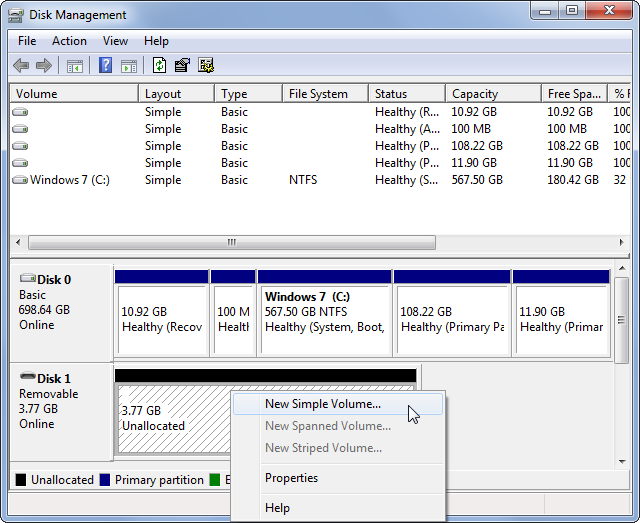
If your drive is partitioned (meaning it contains something other than simply Unallocated infinite) and you still can't encounter it elsewhere in Windows, ensure it has a drive letter prepare. This should happen automatically, but if you lot've manually removed the bulldoze alphabetic character for some reason, the volume may not be accessible in Windows.
To alter the drive letter, right-click the removable drive's segmentation and select Change Bulldoze Alphabetic character and Paths. In case the device doesn't already have a letter of the alphabet, click Add and choose 1. If it does, click Modify and try another one.
Something subsequently in the alphabet, like G or J, is standard for removable drives and will work fine. Avoid earlier letters like A andC, which are reserved by Windows for other purposes.
After changing the drive letter, you might want to display all drives in This PC to make sure it shows upwardly.
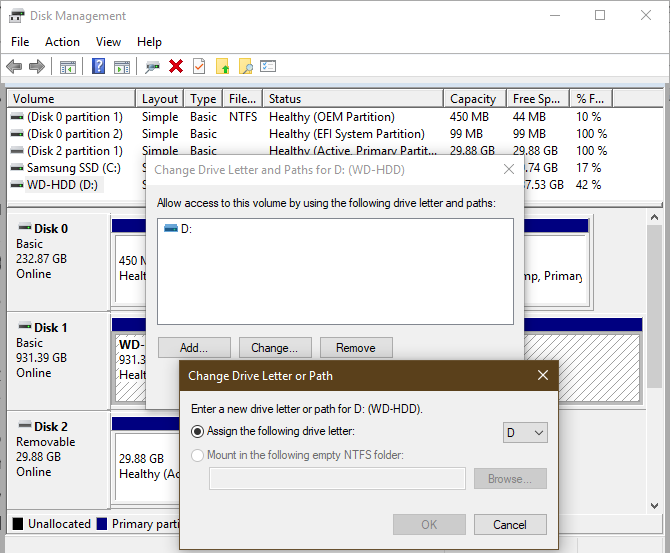
6. Format the External Drive
If the bulldoze appears to exist partitioned, but Windows all the same can't access it, it'south probably partitioned with a different file arrangement.
For example, you may have formatted the drive with the ext4 file system from Linux, or APFS on a Mac. Windows can't read these file systems. Yous'll thus need to reformat the drive with a file system Windows tin admission, such as NTFS, exFAT, or the older FAT32, and then Windows will recognize it.
To reformat a partition in the Deejay Management utility, right-click information technology and select Format.
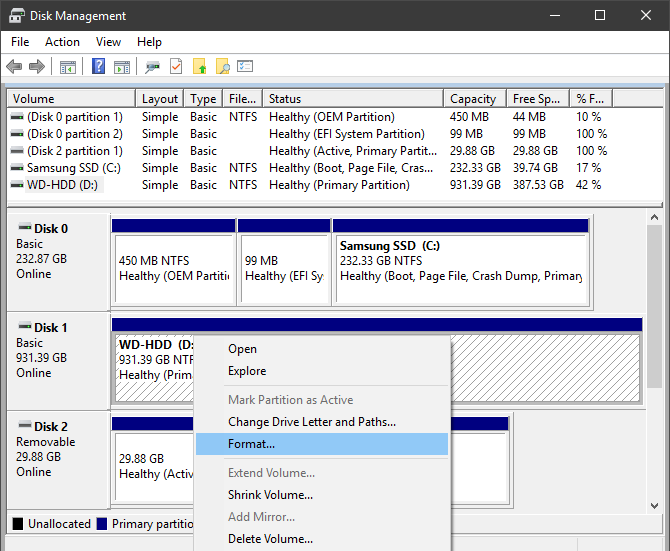
Note that formatting volition erase all files on your bulldoze, so you should copy any important files on information technology to another device before continuing. If the drive is formatted for use on a Linux or Mac machine, take information technology to a computer running that Bone to dorsum up the files before you lot format it.
When y'all format, you can give the drive a new name if you lot similar. Leave Resource allotment unit size as Default; leaving Perform a quick format checked is fine too. More chiefly, you'll need to select a file system. Which one you should cull depends on the type of drive and what you use it for.
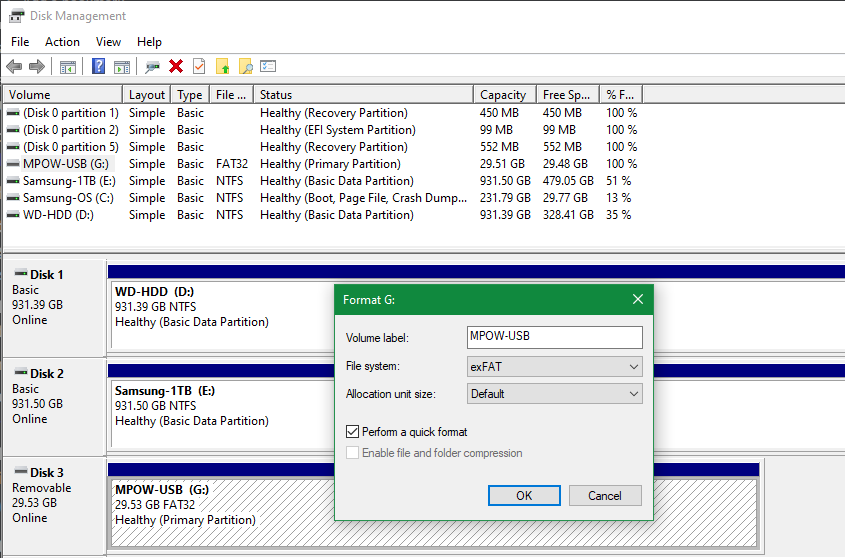
Which File System Should I Choose?
If y'all have a modest wink drive, it likely came formatted as FAT32. Despite its age, this file format is still used for minor storage devices due to its broad compatibility. However, it's not a perfect option.
FAT32 can't salvage files over 4GB, and but supports volumes up to 2TB. It's unlikely that you'll run into either of these issues using a flash bulldoze, just they are still limitations. The main reason to apply FAT32 is that it works with pretty much any device, such as cameras, media players, game consoles, and more.
exFAT, on the other hand, is a more than mod successor to FAT32. Information technology doesn't enjoy the same level of ubiquity of FAT32, but it's free from the file size restrictions of the older format. exFAT likewise performs faster in tests.
As a outcome, nosotros recommend exFAT for pocket-sized removable devices like flash drives, unless yous have a specific compatibility reason to use FAT32. We've compared FAT32 and exFAT if you're interested in a deeper wait at the differences.
The other options is NTFS. This is the modern file organization standard for Windows, but there's nothing to gain by using it on a flash drive. Many older devices aren't compatible with NTFS, and information technology has a lot of overhead that's unnecessary on smaller drives.
It'south fine to apply NTFS for large external hard drives that y'all volition only use with Windows computers. But if you ever plan to apply the deejay with other machines, pick exFAT instead.
Now Your External Bulldoze Is Recognized and Showing Upwards Once again!
Following this process when external hard drives don't show up should solve most of the disk recognition bug you'll run across. If you've tried the bulldoze with multiple computers and it never shows up in the Deejay Management window later on these steps, the drive is probably expressionless.
Thankfully, in that location are lots of bang-up choices for replacement external drives that don't toll a lot of money.
About The Writer
How to Repair External Hard Disk Not Detected
Posted by: kennedyonessince1951.blogspot.com

0 Response to "How to Repair External Hard Disk Not Detected Updated"
Post a Comment